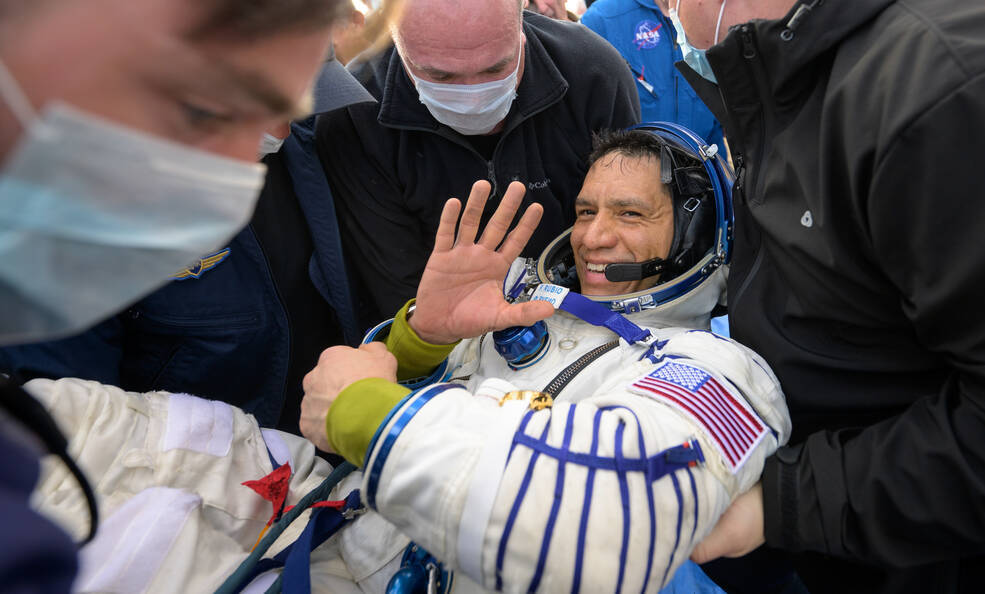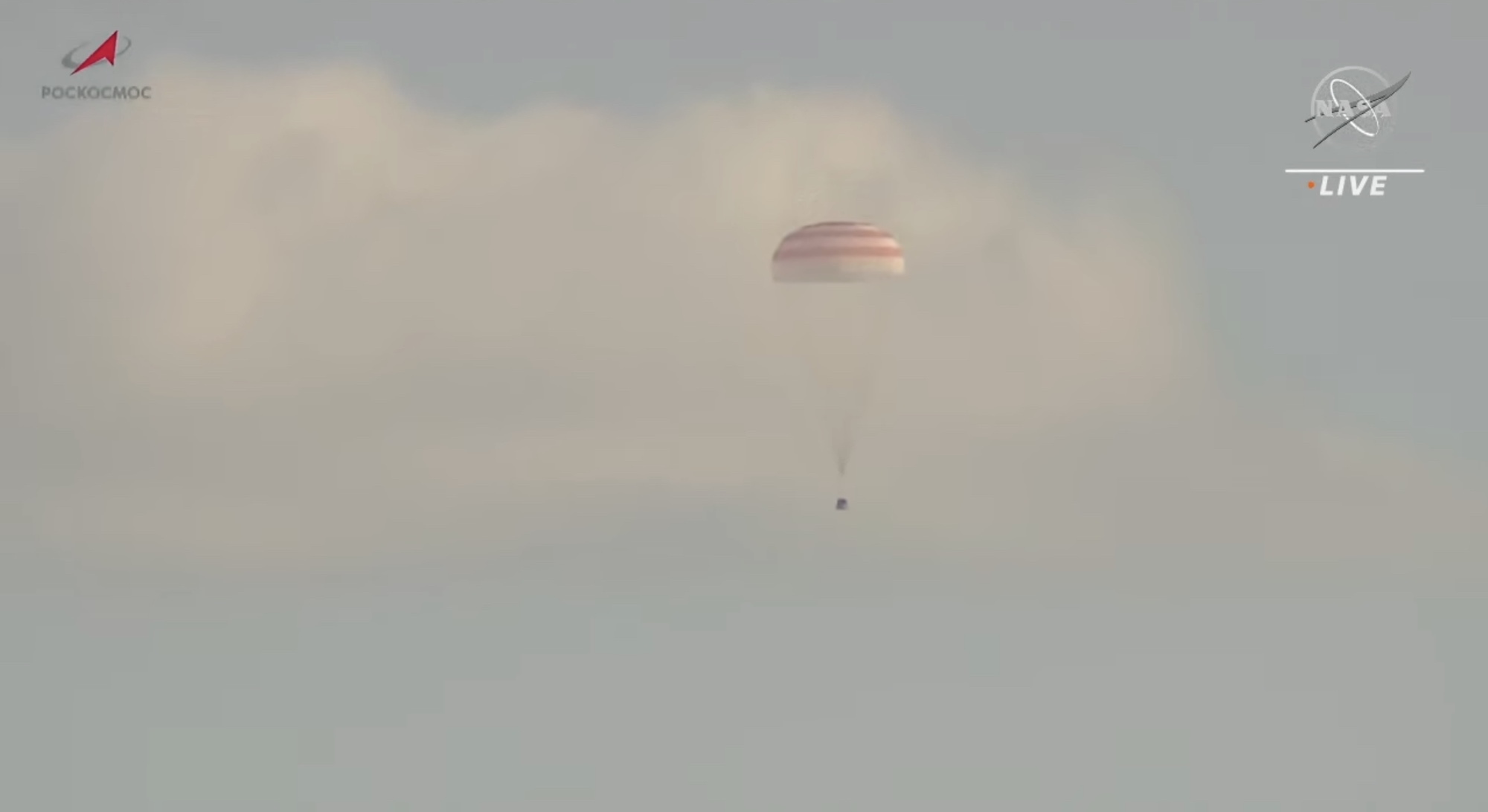28.09.2023

Expedition 69 NASA astronaut Frank Rubio is helped out of the Soyuz MS-23 spacecraft just minutes after he Roscosmos cosmonauts Sergey Prokopyev and Dmitri Petelin, landed in a remote area near the town of Zhezkazgan, Kazakhstan on Wednesday, Sept. 27, 2023. The trio are returning to Earth after logging 371 days in space as members of Expeditions 68-69 aboard the International Space Station. For Rubio, his mission is the longest single spaceflight by a U.S. astronaut in history.
Lee esta nota de prensa en español aquí.
After spending an American record-breaking 371 days in space, NASA astronaut Frank Rubio safely landed on Earth with his crewmates Wednesday.
Rubio departed the International Space Station, along with Roscosmos cosmonauts Sergey Prokopyev and Dmitri Petelin, at 3:54 a.m. EDT, and made a safe, parachute-assisted landing at 7:17 a.m. (5:17 p.m. Kazakhstan time), southeast of the remote town of Dzhezkazgan, Kazakhstan.
“Frank’s record-breaking time in space is not just a milestone; it’s a major contribution to our understanding of long-duration space missions,” said NASA Administrator Bill Nelson. “Our astronauts make extraordinary sacrifices away from their homes and loved ones to further discovery. NASA is immensely grateful for Frank’s dedicated service to our nation and the invaluable scientific contributions he made on the International Space Station. He embodies the true pioneer spirit that will pave the way for future exploration to the Moon, Mars, and beyond.”
Rubio launched on his first spaceflight on Sept. 21, 2022, alongside Prokopyev and Petelin. Rubio’s spaceflight is the longest single spaceflight by a U.S. astronaut, breaking the record previously held at 355 days by NASA astronaut Mark Vande Hei.
During his mission, Rubio completed approximately 5,936 orbits and a journey of more than 157 million miles, roughly the equivalent of 328 trips to the Moon and back. He witnessed the arrival of 15 visiting spacecraft and the departure of 14 visiting spacecraft representing crewed and uncrewed cargo missions.
Rubio’s extended mission provides researchers the opportunity to observe the effects of long-duration spaceflight on humans as the agency plans to return to the Moon through the Artemis missions and prepare for exploration of Mars.
Rubio, Prokopyev, and Petelin launched aboard the Soyuz MS-22 spacecraft but, due to a coolant leak, returned to Earth aboard the Soyuz MS-23. The affected Soyuz MS-22 capsule returned without its crew after the Soyuz MS-23 capsule launched as a replacement on Feb. 23, 2023.
Following post-landing medical checks, the crew will return to Karaganda, Kazakhstan. Rubio will then board a NASA plane bound for his return to Houston.
During his record-breaking mission, Rubio spent many hours on scientific activities aboard the space station, conducting a variety of tasks ranging from plant research to physical sciences studies.
With the undocking of the Soyuz MS-23 spacecraft, Expedition 70 officially began aboard the station. NASA astronauts Loral O’Hara and Jasmin Moghbeli remain aboard the orbital outpost alongside ESA (European Space Agency) astronaut Andreas Mogensen, who became station commander Sept. 26, JAXA (Japan Aerospace Exploration Agency) astronaut Satoshi Furukawa, and Roscosmos cosmonauts Konstantin Borisov, Oleg Kononenko, and Nikolai Chub.
Mogensen, Moghbeli, Furukawa, and Borisov will return to Earth in February 2024, after a short handover with the crew of NASA’s SpaceX Crew-8 mission. O’Hara is scheduled to return to Earth in March 2024, while Kononenko and Chub will spend a year aboard the station, returning in September 2024.
Quelle: NASA
+++
Soyuz returns ISS crew after record-setting stay

The Soyuz MS-23 capsule descends to Earth under its parachute just before landing in Kazakhstan Sept. 27. Credit: NASA TV
WASHINGTON — A Soyuz capsule landed in Kazakhstan Sept. 27, returning two Russians and one American from the International Space Station after more than a year in orbit.
The Soyuz MS-23 spacecraft landed in its designated landing zone in Kazakhstan at 7:17 a.m. Eastern. The spacecraft had undocked from the station’s Prichal module at 3:54 a.m. Eastern.
On board the Soyuz were Roscosmos cosmonauts Sergey Prokopyev and Dmitri Petelin and NASA astronaut Frank Rubio. They launched to the station last September on the Soyuz MS-22 spacecraft for what was originally planned to be a typical six-month stay.
Those plans changed, though, when the Soyuz MS-22 spacecraft suffered a coolant leak in December. NASA and Roscosmos decided weeks later to not use that spacecraft to bring back the crew, launching an uncrewed Soyuz MS-23 in February to take its place. The crew who were to fly to the station on Soyuz MS-23 in March — Oleg Kononenko, Nikolai Chub and Loral O’Hara — were bumped to Soyuz MS-24, which launched to the station Sept. 15.
NASA and Roscosmos extended the stay of Prokopyev, Petelin and Rubio by six months. The three spent 371 days in space, the third-longest spaceflight after the 438 days spent by Valeri Polyakov in 1994 and 1995 and 380 days spent by Sergei Avdeyev in 1998 and 1999, both on the Mir space station.
The three set the record for longest stay on the ISS. Rubio also set the record for longest single spaceflight by an American, breaking the mark of 355 days set by Mark Vande Hei in 2021 and 2022.
In a call with reporters from the ISS Sept. 19, Rubio admitted he would not have signed up for a year in space if offered in advance. “If they had asked me up front, before you start training,” he said, “I probably would have declined, and that’s only because of family.”
However, he said that once he started training, he was committed to the mission regardless of its length. “Ultimately, that’s our job, and we have to get the mission done.”
He said the hardest point in the mission was when his mission was extended by six months. “That decision really took a couple of months,” he said, as NASA and Roscosmos evaluated the options, giving him and his family the ability to prepare for that extension. “Although it was difficult, honestly I had already come to terms with it.”
The extended mission, he noted, offered valuable experience for future long-duration missions, such as eventual missions to Mars. “The psychological factor was more of a factor than I had expected, but again, just having a really good team around you is such an incredible help,” he said, including finding the right balance between work and relaxation.
Rubio said he looked forward to reuniting with his wife and children, as well as some peace and quiet. “We’re blessed enough to have a quiet backyard, and I think just going out in the yard and enjoying the trees and the silence,” he said, a contrast to the “constant hum” of the machinery on the station. “I’m looking forward to being outside and enjoying the peace and quiet.”
Quelle: SN
